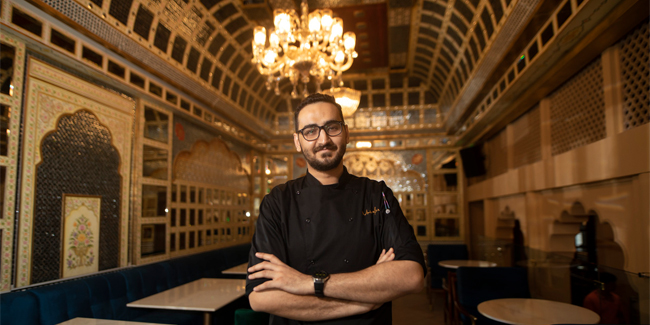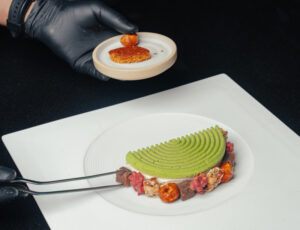Categories Pastry Chef Articles
Ruchit Harneja: ‘A balanced amount of sweetness can actually aid digestion’

Ruchit Harneja, Executive Pastry Chef at Musaafer restaurant in Houston (United States), is inspired by the cultural heritage of his country, India, and his childhood experiences to create desserts that combine traditional flavors and haute pastry techniques.
Due to a severe history of diabetes in his family, he began looking for alternatives to design a contemporary and healthy Indian pastry with high nutritional value through Ayurvedic spice blends and superfoods. We spoke with him about his interesting pastry approach and global trends in the sector, among other issues.
Why did you decide to become a pastry chef?
From a young age, growing up in the vibrant city of Jaipur, I was immersed in the rich culinary heritage of India, especially the exquisite desserts that are renowned worldwide. With a deep-rooted passion for food and cooking, my journey as a pastry chef began with the influence of my mother and grandmother, who taught me the intricacies of traditional Indian cooking.
Driven by this early exposure and fueled by my love for culinary arts, I pursued formal education in Hotel Management and underwent training at the prestigious Taj Mahal Hotel in New Delhi. It was during this time that my talent as a pastry chef began to emerge. Winning some of the pastry competitions at the Institute of Hotel Management in Bangalore solidified my passion even more.
However, it was a personal experience within my own family that truly shaped my path. Dealing with a history of severe diabetes, I felt a strong sense of responsibility to find healthier alternatives and modify traditional dessert recipes. This led me on a quest to combine my knowledge of applied nutrition and food science with my expertise in pastry arts, ultimately creating a benchmark for healthy Indian desserts in a contemporary way.
In summary, my decision to become a pastry chef was a harmonious fusion of my deep-rooted culinary upbringing, a desire to create healthier desserts, and an unrelenting passion for the art of pastry.
‘I aim to preserve the essence of traditional Indian sweets while presenting them in innovative and visually appealing ways’
What is traditional pastry in India like? And how do you reinterpret it to give it a more contemporary air?
Traditional pastry in India is a fascinating blend of diverse cultural influences and a rich culinary heritage. It is deeply rooted in the country’s history, conquests, and regional traditions. The evolution of Indian pastry can be traced back centuries, shaped by the contributions of various dynasties, trade routes, and colonial powers that left their indelible mark on the country.
To reinterpret traditional Indian pastry and infuse it with a contemporary air, I draw inspiration from these historical influences while embracing modern culinary techniques and ingredients. I aim to preserve the essence of traditional Indian sweets while presenting them in innovative and visually appealing ways. By incorporating elements like molecular gastronomy, artistic plating, and playful flavor combinations, I create desserts that pay homage to the past while captivating the modern palate.
Moreover, I emphasize the use of healthier alternatives and mindful ingredient choices in my reinterpretations. By exploring the vast array of Indian superfoods and Ayurvedic ingredients, I add a nutritious twist to traditional recipes, making them more suitable for health-conscious individuals without compromising on taste or cultural authenticity.
‘The kind of pastry I defend is one that is mindful of the impact it has on our health without compromising on flavor and enjoyment’
As you have explained, due to your family’s history of severe diabetes, you reconsidered your trade, looked for healthy alternatives and modified recipes. What kind of pastry do you defend?
The kind of pastry I defend is one that is mindful of the impact it has on our health without compromising on flavor and enjoyment. I strive to create desserts that are lower in sugar, incorporate nutritious ingredients, and utilize innovative techniques to enhance taste and texture.
Furthermore, I advocate for the inclusion of high-fiber ingredients, whole grains, and superfoods in pastry preparations. These additions not only contribute to the nutritional value of the desserts but also support overall well-being.
In addition to modifying recipes, I also focus on portion control and mindful eating. By offering smaller portion sizes, I encourage individuals to savor and appreciate the flavors of the pastry without overindulging. I believe that dessert should be enjoyed as part of a balanced diet and a holistic approach to wellness.
Ultimately, the kind of pastry I defend is one that embraces the concept of balance, nourishment, and pleasure. I aim to inspire others to make informed choices, explore healthier alternatives, and realize that a nutritious dessert is indeed possible. It is my passion to redefine the perception of pastry, proving that it can be a delightful and guilt-free experience, even for those with specific dietary considerations.
What would you say to all those who defend that sugar is synonymous with a sweet tooth? Is a tasty low-sugar dessert possible?
In my quest to debunk the myth that eating desserts is detrimental to health, I have delved into the science behind digestion and the role of sweets in our diet. It is fascinating to discover that a balanced amount of sweetness can actually aid digestion. The release of saliva triggered by consuming something sweet helps relax stomach muscles, allowing the food we’ve eaten to settle easily. Therefore, when enjoyed in the desired quantity, sweet food can be nourishing for the spleen. However, it is important to maintain balance and avoid consuming unbalanced meals that lead to uneven blood sugar levels.
With my pastry creations, I pay careful attention to controlling the amount of sugar and carbohydrates, ensuring they are within a healthy range.
One aspect that sets my desserts apart is the unique style of incorporating Ayurvedic spice blends that I have invented specifically for Indian desserts. I differentiate spices based on their cooling, warming, baking, and digestive nature. Each spice blend has a distinct note and reaction when paired with different ingredients and cooking techniques. This approach reflects the rich influence of spices in Indian cuisine since ancient times.
‘One aspect that sets my desserts apart is the unique style of incorporating Ayurvedic spice blends that I have invented specifically’
You regularly use superfoods like lotus seeds and millet. What do these types of ingredients add to your recipes?
In my pastry creations, I have a deep appreciation for the incredible potential of indigenous Indian superfoods. I am fascinated using ingredients like Indian millets and grains, Moringa leaves, Lotus seeds, and more. By utilizing these superfoods in my pastry creations, I strive to reconnect with our culinary heritage while promoting the consumption of nutrient-dense ingredients.
Indian millets and grains, with their unique flavors and textures, add a delightful twist to my pastry creations. They are rich in fiber, essential minerals, and vitamins, making them valuable additions to a balanced diet. By incorporating these grains into my desserts, I aim to showcase their versatility and highlight their health-promoting properties.
Lotus seeds, also known as Makhana, have been consumed in India for centuries and are revered for their numerous health benefits. These seeds are low in fat and high in protein, fiber, and essential minerals. They lend a unique texture and delicate flavor to my pastry creations, adding a touch of elegance and a boost of nutritional value
‘By utilizing the superfoods in my pastry creations, I strive to reconnect with our culinary heritage while promoting the consumption of nutrient-dense ingredients’
Since 2018, you have been working as Executive Pastry Chef at the Musaafer neo-Indian restaurant in Houston, where you can taste old regional recipes treated with haute pastry techniques and heterodox pairing of flavors. Are American diners open to trying new things or are they rigid when it comes to flavors and formats?
American diners have truly surprised me with their open-mindedness and eagerness to embrace new culinary experiences. They appreciate the artistry and creativity that goes into reinterpreting traditional Indian desserts. They are not afraid to explore new flavors, textures, and formats, which has allowed me to showcase the diverse and rich culinary heritage of India.
At Musaafer, we see our dessert program as an educational tour for American diners, providing them with a unique opportunity to expand their gastronomic horizons. In fact, I am thrilled to share that we are expanding our culinary journey to New York City, where we will be opening our next Musaafer outpost. This is a significant milestone for us, and it speaks volumes about the growing demand and acceptance of Neoteric Indian cuisine in the United States. I am confident that the vibrant and diverse food scene in New York City will provide us with an ideal platform to further captivate American diners and continue setting new benchmarks in the world of culinary innovation.
‘The world of pastry is currently experiencing a thrilling revolution, driven by chefs who are breaking boundaries, embracing heterodox food pairings, and blending global cuisines to create extraordinary flavors’
What do you think are the pastry trends in the world?
The world of pastry is currently experiencing a thrilling revolution, driven by chefs who are breaking boundaries, embracing heterodox food pairings, and blending global cuisines to create extraordinary flavors. As a pastry chef with a passion for innovation and a deep understanding of health-focused ingredients like superfoods, I believe the future of pastry lies in the freedom to explore and transcend traditional culinary boundaries.
In this era of culinary creativity, it is crucial to move away from restricting our food to specific cuisines. Instead, we should embrace the formation of new cuisines that arise from the fearless blending of global flavors and techniques. This allows us to push the boundaries of flavor combinations, challenge preconceived notions, and create desserts that transcend cultural confines.
As a pastry chef, I am committed to this visionary approach, constantly seeking inspiration from diverse culinary traditions, incorporating health-focused ingredients, and challenging the status quo.
‘While India is undoubtedly experiencing a pastry boom with talented pastry chefs making their mark, I believe there is still untapped potential in showcasing the flavors and techniques that I specialize in’
What plans do you have for the future? Have you thought about setting up a pastry shop now that India seems to be experiencing a pastry boom?
My vision for the future is driven by a desire to introduce my unique style of Indian-inspired desserts to a wider audience, particularly in the Western countries. While India is undoubtedly experiencing a pastry boom with talented pastry chefs making their mark, I believe there is still untapped potential in showcasing the flavors and techniques that I specialize in.
Opening Musaafer in the United States has reinforced my belief in the immense opportunity and appreciation for my desserts in this country. I firmly believe that there is a significant gap and curiosity in the United States for the kind of desserts I create. People here are eager to embark on a culinary adventure, and I am honored to be the driver of that journey.
Inspired by tradition, driven by innovation, and guided by passion, I am committed to shaping the future of pastry, one delectable creation at a time.





